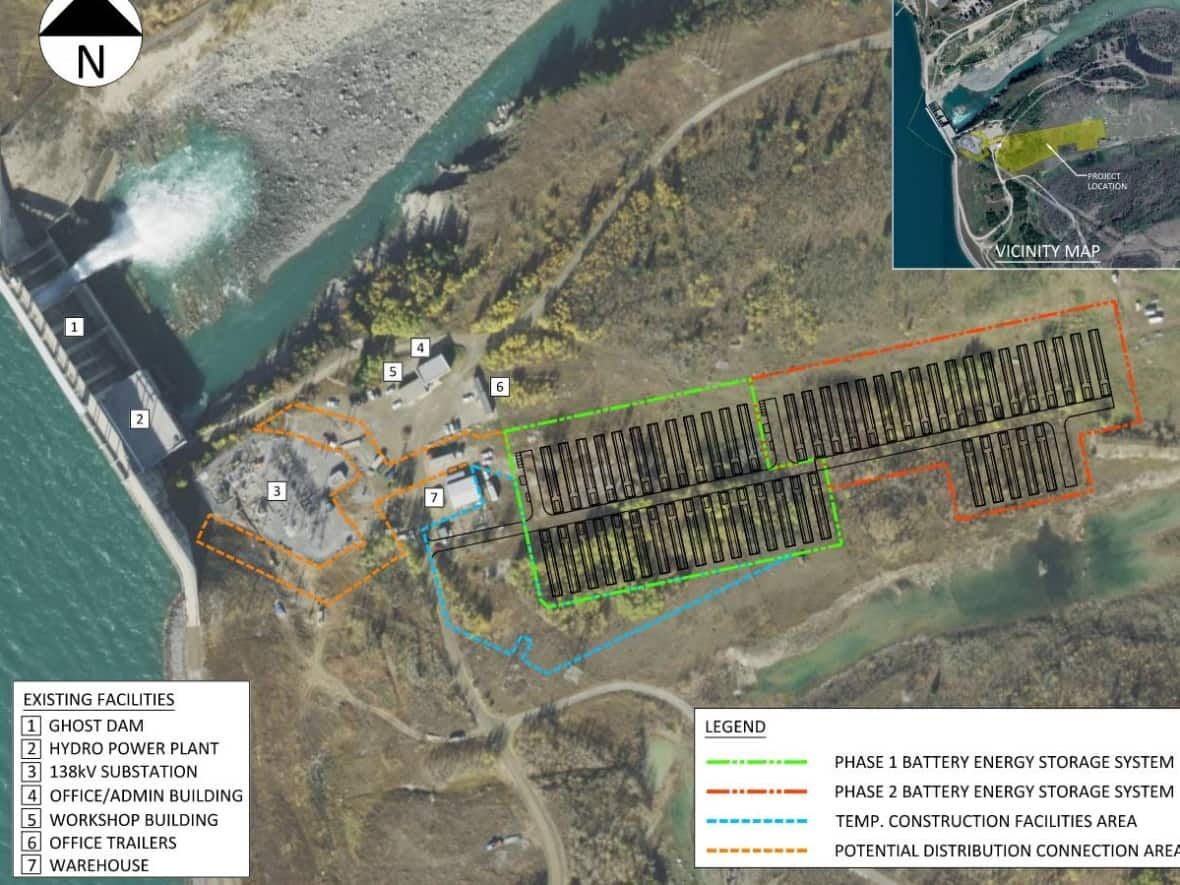TransAlta seeks to build a battery energy storage facility near Ghost Reservoir

TransAlta has officially filed its application with the Alberta Utilities Commission (AUC) to build a battery energy storage facility near the Ghost Reservoir on the Bow River while addressing concerns about safety and emergency planning in the event of a fire or leak.
The project will be capable of supporting the grid with a maximum power rating of 180 megawatts of electricity, making this one of the largest storage facilities of its kind in the province.
The company says the lithium-ion batteries will be charged by electricity from TransAlta's existing hydroelectric facility at the reservoir, 15 kilometres west of Cochrane.
Electricity from the batteries will then be pumped back into the provincial power grid when demand for power is high.
"We're taking that energy from the hydro facility, storing it until it's needed and putting it back on the grid at a later time," said Chris Teare, a project manager with TransAlta.

In a letter to stakeholders last month, Teare responded to concerns related to the potential for battery fires and leaks, noise from the facility and whether more power transmission lines will have to be strung up.
"Battery manufacturers have been very focused over the last few years on fire safety and incorporating lessons learned from past events," he wrote.
"As a result of these continuous design improvements, battery facilities are considered quite inherently safe."
Teare says the same lithium-ion battery technology proposed for the Ghost Reservoir project is being deployed in millions of electric vehicles around the world "and is proving a very safe track record given the recent advancements in battery chemistry and safety protocols."
The company also says the risk of the batteries leaking contaminants into the Bow River will be minimized by leak proof battery modules.
"Individual battery cells are fully sealed and further contained within the battery modules (sealed enclosures), minimizing the risk of a leak from the battery."

The company says it has completed a noise impact assessment and expects the project to fall below permissible sound levels set by the AUC. TransAlta says no additional power lines will be needed for the project.
One of the most high profile fires at a battery energy storage system (BESS) occurred at an Arizona Public Service facility in 2019. The fire resulted in an explosion and injured several first responders. A report concluded that an internal cell failure within one battery cell triggered the blaze.
Fire prevention protocols, systems
The Calgary-based utility says the Ghost Reservoir project, with an estimated cost of $120 million, will include a number of fire prevention protocols and systems designed to prevent, detect and extinguish any fires.
Teare says the batteries will be constantly monitored and immediately shut down if any abnormalities are detected. Each enclosure will have smoke and gas detectors along with an aerosol-based fire suppressant. He says there will be enough spacing between the battery units to reduce the risk of a fire spreading from one unit to another.
He says the emergency response plan will include Rocky View County, where the project will be located.
"We do anticipate developing a detailed emergency response plan with first responders and incorporating all of this information and building in requirements that the county may have with their first responders," he said.
Power 'grid of the 21st century'
The Pembina Institute, a non-profit think tank focused on energy, says while battery energy storage systems are not a panacea or a silver bullet, they can provide a more resilient and reliable service — particularly during extreme climate events.
"If the whole grid goes down, and you have a plant that's attached to a battery, you can actually bring that plant back online, said Binnu Jeyakumar, the director of clean energy.
She says batteries can also help bolster the grid when wind and solar energy sources aren't available — and they will help decarbonize the power grid.
TransAlta's first BESS is a 10 MW facility at its Summerview wind farm near Pincher Creek, Alta.

"We need to make sure we stop emitting carbon emissions from our grid. And so we need to see a whole bunch of different technological solutions to that, and batteries [are] a really key component of that."
The federal government is aiming for a net-zero electricity grid by 2035.
Jeyakumar would like to see the province play a bigger role in reaching that target by offering incentives to attract investments on a much larger scale.
TransAlta is planning to invest hundreds of millions of dollars into renewable energy projects over the next few years.
"We see TransAlta building two gigawatts of renewable electricity by 2025. That's an estimated $3 billion of investment and will take our emissions down by 75 per cent from 2015 levels," said Chelsea Donelon, a senior advisor with TransAlta's carbon policy technology and strategy team.
Project review
TransAlta officially filed its application for what it calls the WaterCharger project with the AUC last week and is hoping for that process to be complete this year.
It's also working with Rocky View County on a land use redesignation and eventually a development permit for the three-hectare site. It will also select a vendor to provide the batteries.
It's unclear if or when public hearings will be held.
Bryan Labby is an enterprise reporter with CBC Calgary. If you have a good story idea or tip, you can reach him at bryan.labby@cbc.ca or on Twitter at @CBCBryan.


